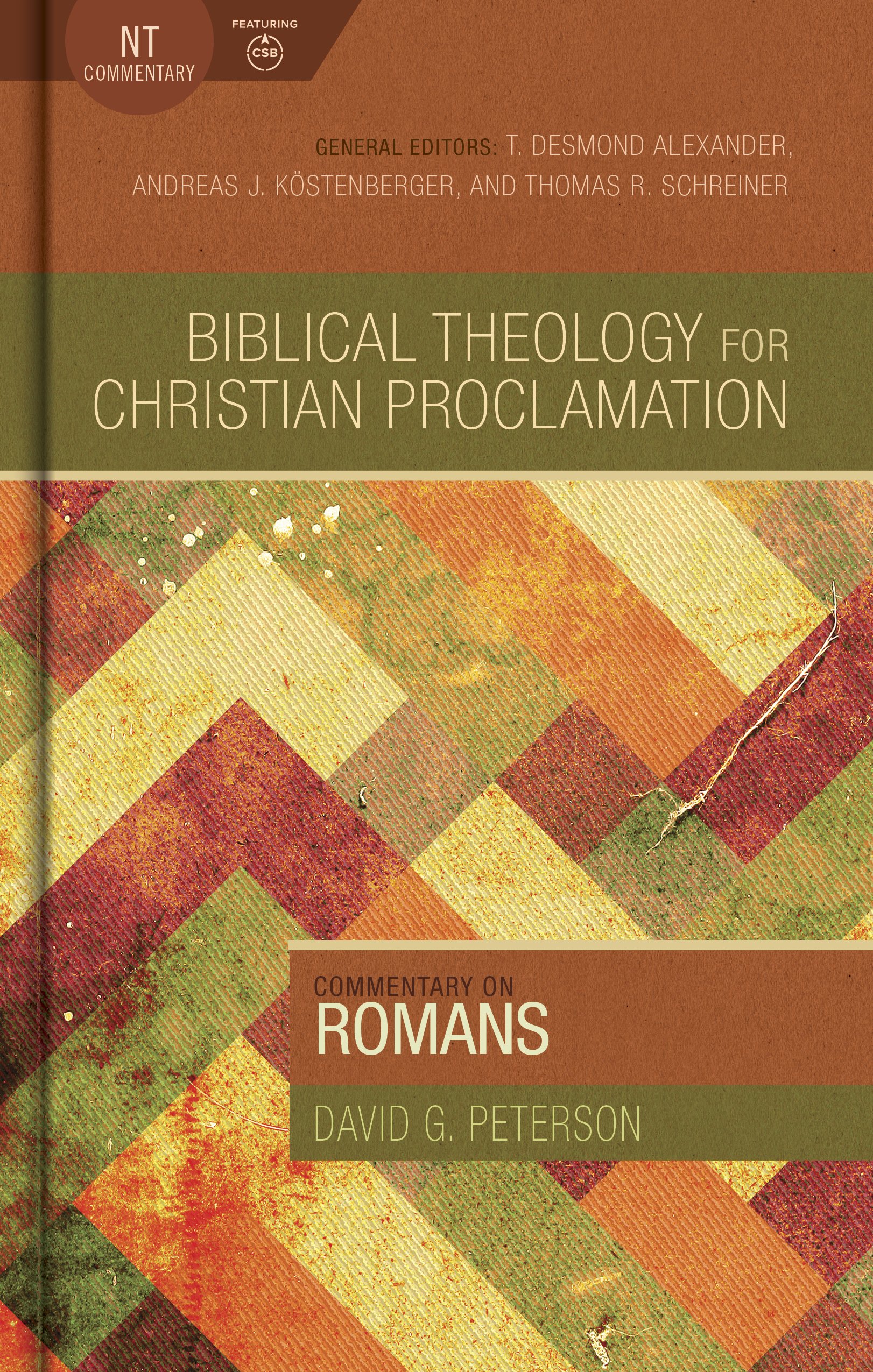Reviewed by John D. Harvey
About the Author
David G. Peterson is emeritus faculty member at Moore Theological College in Sydney, Australia. His other books include Hebrews and Perfection, Engaging with God: A Biblical Theology of Worship, Possessed by God: A New Testament Theology of Sanctification and Holiness, Christ and his People, The Acts of the Apostles, Transformed by God: New Covenant Life and Ministry, and Encountering God Together: Biblical Patterns for Ministry and Worship.
About the Series
When complete, the Biblical Theology and Christian Proclamation series will comprise forty volumes that “explore the theology of the Bible in considerable depth, spanning both Testaments.” Each volume includes a discussion of the central themes of the biblical book(s), while also relating those themes to the overall canon of Scripture. David Peterson’s volume on Romans is the third in the series, preceded by volumes on Hebrews and 1-2 Timothy and Titus.
Content
In thirty-nine pages of Introduction, Peterson reaches standard conclusions on introductory matters. (1) The book is a typical (if longer) Pauline letter, sent to Rome from Corinth sometime during A.D. 57–58. (2) All sixteen chapters of the letter are original, including the doxology of 16:25–27 but not the grace benediction of 16:24. (3) Paul’s purposes in writing included equipping the Romans for debates with Jews in Rome, addressing the continuity between Judaism and Christianity, and securing support for his mission to Spain. (4) The structure consists of sections that alternately confirm the gospel (1:18–32; 3:21–27; 5:1–11; 6:1–23; 8:1–39; 12:1–13:14) and defend against Jewish objections (2:1–3:20; 3:27–4:25; 5:12–21; 7:1–25; 9:1–11:36; 14:1–15:7).
Peterson devotes forty-nine pages to Biblical and Theological Themes. He gives priority to the way in which Paul reflects on key events in the storyline of the Bible. Those events include creation, sin and judgment, God’s promises to Abraham, God’s choice of Israel, Israel’s failure, and God’s promises of ultimate deliverance. Other significant themes include the gospel, Scripture, God, righteousness and justification, Israel and the church, sanctification and holy living, and apostolic ministry.
The largest portion of the volume consists of 474 pages of exposition on thirty text sections of varying length (from two verses to twenty-nine verses). Peterson structures the discussion of each text section using five components: (1) the Christian Study Bible’s translation of the passage; (2) a summary of the passage’s context; (3) an overview of the passage’s structure, including a brief outline; (4) a verse-by-verse exposition; and (5) a “bridge” from the first-century letter to twenty-first-century readers.
The volume concludes with thirteen pages of bibliography (15 commentaries, 115 books and articles) and forty-four pages of indices (name, subject, Scripture, extrabiblical sources).
Evaluation
Peterson’s treatment of the letter is concise but thorough. It is based on an analysis of the Greek text but is accessible to readers who are seeking a commentary at a less technical level. Peterson interacts with the biblical text, biblical theology, and biblical scholarship. Although he does not include any discussion of the New Perspective on Paul, Peterson’s decisions on pertinent interpretive details run counter to that approach. His understanding of the alternating structure is helpful, although his proposed overall recursive/chiastic organization is less persuasive. The bridge discussions that accompany the exposition of each text section are helpful, although they are shorter (250–300 words) than might have been expected in a work focused on biblical theology. The following review of decisions on selected interpretive issues in the commentary proper will provide a sense of Peterson’s theological perspective.
- “Righteousness of God” (1:16–17) describes “how God acts to establish justice for his people and put them right with himself (105–6).
- The Gentiles who “do what the law demands” (2:14–16) are Gentile Christians (147–48).
- “Works of law” (3:20) refers not to Jewish “boundary markers” but to the works the law demands (180–81).
- “Faith of Jesus Christ” (πίστις Ἰησοῦ Χριστοῦ in 3:22) is an objective genitive and should be translated “faith in Jesus Christ” rather than “faithfulness of Jesus Christ” (189–91).
- “Atoning sacrifice” (CSB translation of ἱλαστήριον in 3:25) describes propitiation (satisfaction of wrath) rather than expiation (194–97).
- The relative clause ἐφ’ ᾧ ἥμαρτον in 5:12 denotes cause (“for all sinned”) and points to the truth that “human beings became sinners not merely by imitating Adam’s transgression, but ‘they were constituted sinners by him and his act of disobedience’” (247–48).
- Peterson takes no position on how Adam’s sin was passed on to humankind (e.g., natural headship, mediate imputation, immediate imputation).
- The “I” in 7:7–12 is Paul speaking either in the name of Adam or as a representative of humanity in Adam (290–91), while the “I” in 7:13–25 reflects “Christian hindsight” (295–97).
- Christ is “the end of the law” (τέλος νόμου in 10:4) because now that Messiah has come, “the law has completed its task of revealing God’s righteousness” (376–77).
- Peterson follows Dunn in concluding that “all Israel” in 11:25 refers to “Israel as a whole … whose corporate identity and wholeness could not be lost even if in the event there were some (or even many) individual exceptions” (424–25).
- The “governing authorities” (ἐξουσίαις ὑπερεχούσαις) in 13:1 are imperial and local officials in the governmental system rather than “angelic powers” (463).
- Both groups described as “weak” and “strong” in 14:1–15:13 include Jews and Gentiles (23).
Summary
Peterson’s commentary is solidly evangelical and accessible to a wide range of readers. It breaks little new ground but offers an appropriate treatment of Paul’s letter. In keeping with the intent of the series, Peterson’s focus on biblical theology adds a helpful dimension to his exposition. If you are regularly engaged in a ministry of preaching or teaching and are thinking about adding another commentary on Romans to your library, this volume is definitely worth your consideration.
John D. Harvey is Dean and Professor of New Testament at Columbia Biblical Seminary of Columbia International University, Columbia, SC.
